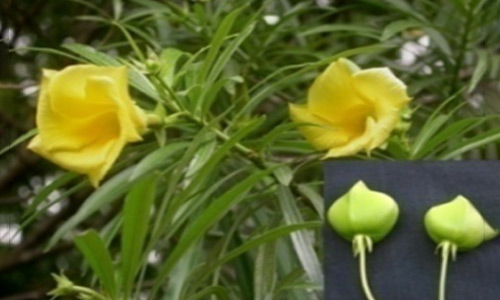|
Division
|
Angiosperms |
|
Class
|
Dicotledons |
|
Subclass |
Gamopetalae |
|
Series |
Hypogynae |
|
Order |
Gentianales |
|
Family
|
Apocynaceae |
|
Genus
|
Thevetia |
|
Species
|
peruviana |

|
Etymology:
|
In honour of Andre Thevet (1502-1592), French monk who collected plants from Brazil. |
|
Botanical name:
|
Thevetia peruviana (Pers.) K. Schum. ( T. neriifolia Juss. ex Steud., Cascabela thevetia (L.) Leppold) |
|
Local/Trade Names: |
Yellow Oleander, Be-Still Tree, Trumpet Flower, Lucky Nut, Bastard Oleander, Pila Kaner |
|
Conservation status: |
Commonly cultivated in India. |
|
Digonestic features: |
Leaves linear-lanceolate; flowers yellow. |
|
Description: |
An evergreen shrub or a small tree. Leaves linear-lanceolate, 10-15 x 0.7-1 cm. Inflorescence a terminal cyme. Flowers golden-yellow, sometimes white or light ochre, fragrant, 5 cm across. Fruit a drupe, broader than long, 3 cm across. Seeds few, flattened, without coma. |
|
Phenology: |
Fls.: Summer and rainy season. |
|
Distribution: |
Tropical America. |
|
Where to see it: |
Near Energy Park. |
|
Uses: |
Tincture of bark is cathartic and emetic; also used as febrifuge. Leaves purgative and emetic. Roots are made into a plaster, applied to tumours. Seeds used as an abortifacient and purgative in rheumatism and dropsy; also used as an elexeteric. They are employed for criminal poisoning of cattle. All parts of plant including latex are poisonous and contain glycosides which are the active principles; of these pervoside is the most important. |
Chief Conservator of Forests & Chief Wildlife Warden is the Head of the Department. There is one post of Conservator of Forests & two posts of Deputy Conservator of Forests viz.